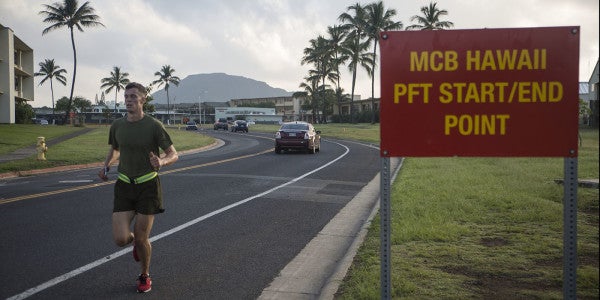The Military Wants To Make Bases More Walkable Because Vehicles Are For The Weak
As Syria heats up, the Gulf states get snippy, and North Korea keeps lobbing rockets, the Department of Defense’s top...

As Syria heats up, the Gulf states get snippy, and North Korea keeps lobbing rockets, the Department of Defense’s top military planners are doing what they always do: reviewing maps, rehearsing routes in their heads, planning to engineer new paths and obstacles, and trying to anticipate where resistance will come from.
Their objective: to make you move around more, you lazy fatbodies.
The Atlantic’s CityLab took a deep dive into how the Pentagon is using “active design” trends in urban planning to make its military bases more amenable to walking, running, biking, and generally not being an unsat dirtbag.
The “Healthy Base Initiative” isn’t new — the Pentagon’s implemented it on 14 installations since 2014 — but in addition to improving healthy food choices on post, DoD planners are also looking for “quick micro-changes” to base infrastructure and family accommodations to encourage active lifestyles, like bike shares, healthy food trucks, and more walking trails.
“Our installations were built for the automobile,” Ed Miles, the Pentagon’s director of strategy and innovation for military community and family policy, told City Lab. “They weren’t built for walking, for biking.” But military bases have one advantage: They’re islands unto themselves, making them great places to experiment with infrastructural tweaks.
What does all that mean to Cpl. Schmuckatelli, though? Here are some examples of the base fixes you could see someday:
- “Signs encouraging people to take the stairs.” But if an officer or senior NCO’s behind you in the hallway, you were probably gonna take those stairs, anyway.
- “Family fitness centers that provide child care while adults exercise.” This is awesome. Kids make you fat. It isn’t their fault (not entirely, anyway), but being able to stash the lovable snotmakers somewhere while we do our daily burpees is really all anyone can ask, ever.
- “A bike-share program” financed with “discretionary commander’s funds.” Apparently, this worked out great at Ft. Belvoir in northern Virginia — “Guys were lined up at lunch for the bikes,” Miles said — but consistent funding is a problem. You can’t expect every base commander to give up his soiree money just to improve service members’’ quality of life, natch.
- “Farmers’ markets.” I think this should be a part of military life, and of garrison training: Your CSA has issued you a box of kale, bok choy, radishes, cantaloupe, and avocadoes. Your mission is to make personal provisions out of them. If you can jury-rig a field office in a container box, you can improvise a healthy lunch.
- “Sidewalks, bike lanes, and commercial centers.” An interesting objection to these ideas that CityLab didn’t raise: Driving on base, rather than walking, cuts down on having to salute as much. I’m 50/50 on this one.
- “Food trucks with nutritious options.” This is a two-part idea. One aspect involves distributing food services all over a base rather than in a single central mall/food court/PX area — again, imagine being able to walk 3 minutes for chow instead of driving 10 minutes. The other idea is to offer healthy choices, but I have never seen a food truck that serves healthy food. Isn’t wonderful hot grease the main draw of food trucks?
These all may sound terrific, and many of the advancements detailed by CityLab have already been made on a variety of bases, from tiny New London to sprawling Fort Bragg. But don’t get too excited about your crunchy, military-supported granola lifestyle just yet.
“Whenever you’ve got to build something on a military installation, things like that are in the planning process for years,” Miles told City Lab. “I mean, years.”
That should give you plenty of time to figure out how to cook the bok choy.